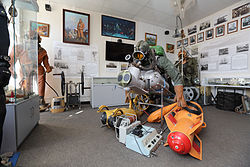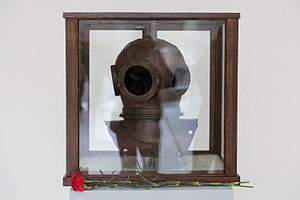| This article does not cite any sources. Please help improve this article by adding citations to reliable sources. Unsourced material may be challenged and removed. Find sources: "Kronstadt Naval Museum" – news · newspapers · books · scholar · JSTOR (May 2015) (Learn how and when to remove this message) |
 Museum exposition Museum exposition | |
| Established | May 4, 2012 |
|---|---|
| Location | Russia, Kronstadt, Андреевская улица, 5 |
| Coordinates | 59°59′46″N 29°45′48″E / 59.99611°N 29.76333°E / 59.99611; 29.76333 |
| Type | Maritime museum |
| Visitors | 10,000 (2014) |
| Founder | Fertoing Ltd. |
| Curator | Vladimir Shatrov |
The Kronstadt Naval Museum is a museum devoted to the history of underwater diving in Russia and the military history of Kronstadt in the 20th century. The museum is located on Kotlin Island in the central part of Kronstadt.
History
The museum was opened on May 4, 2012 by efforts of enthusiasts and financial support of an engineering company Fertoing Ltd. ahead of the anniversary – 130 years of the diving service in Russia. The name of Kronstadt is connected with establishment of the diving service in Russia as the first state military diving school was founded here on May 5, 1882 by the order of Alexander III.
Collection

The exhibition occupies two rooms: the bigger one is devoted to the diving history, the smaller – to the Great Patriotic War, Leningrad Siege, and the Kronstadt military history. The museum houses a wide collection of diving equipment of different times, noteworthy, that all equipment is still operational.
In May 2015, one exhibit returned from the Staraya Derevnya Restoration and Storage Centre of the State Hermitage Museum – the 12-bolt diving helmet that belonged to the Senior Chief Navy Diver Nikita Sergeyevich Myshlyaevskiy, who died underwater in the Gulf of Finland not far from Shepelevo Lighthouse in 1944 during a combat mission.
There is a room devoted to defense of Kronstadt and defenders’ life during the Great Patriotic War. Among witnesses of those hard times are naval distinctive insignias, weapons and bullets, service medals, badges, uniform, damaged helmets, documents, front-line letters, domestic items of peaceful life – toys and bells. Visitors will definitely remember a mortar, mounted machinegun, subgun, captured MP40 submachine gun, articles of German field clothing, pots, peak caps, knives, watches and other belongings of the Winter War soldiers.
Building
The building that houses the Naval Museum was erected at the end of the 19th – beginning of the 20th century and belonged to Aleksandr Mikhailovich Britnev.
Public education
The museum houses a lecture hall for meetings, conferences to promote the Russian history and Kronstadt history in particular, diving service, marine archeology, military history among school children and teenagers.
Management
- Vladimir Shatrov (2012 – present)